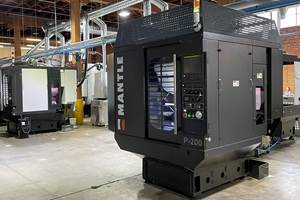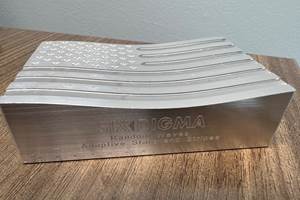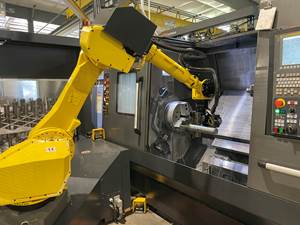All-In for Apprentices
The apprenticeship program at Grob Systems offers a free associate’s degree, a paycheck and the possibility to launch a manufacturing career with the company.
Share






Ever heard of Bluffton, Ohio? It’s a small village in the rural northwestern part of the state with an approximate population of 4,000. It’s also home to Grob Systems, the U.S. branch of Germany-based , builder of universal machine tools and flexible automotive production systems.
Grob Systems was founded in 1983 as a sales and service division for the U.S. market. Bluffton was chosen because it was centrally located among a number of the company’s automotive customers. Grob Systems added manufacturing capacity there in 1991, and its operation has grown to 400 employees and a 323,000-square-foot facility where automotive production systems and related equipment are manufactured.
While the location is ideal in terms of customer support, there isn’t a deep pool of experienced manufacturing personnel to tap nearby. Therefore, the company established a paid apprenticeship program from the get-go, largely based on its parent company’s model. Today, the program is led by training supervisor Mike Hawk, who has initiated changes that have enticed more young people to consider applying. Perhaps the biggest change came in 2012. That’s when the potential to receive a journeyman’s card through the program was replaced with the ability to earn an associate’s degree—at no cost to the apprentice.
Simply put, the program offers an opportunity to learn a trade and get a degree in manufacturing engineering for free through nearby Rhodes State College, while earning a paycheck.
This change represents a necessary progression for the company’s apprenticeship model here in the States, Mr. Hawk contends. “How many kids (or parents) know what a journeyman’s card is? On the other hand, they’re certainly familiar with an associate’s degree,” he explains.
The change seems to be paying dividends. Last year, the company received more than 100 applications, which is three times as many as it would get when a journeyman’s card was offered. Mr. Hawk and other Grob Systems representatives frequently visit schools in a 50-mile radius of the company’s campus, and the company currently has more than 25 feeder high schools for its program.
So how does it work? First, the grades must be there. Mr. Hawk looks for applicants with a GPA of 3.0 or higher who are particularly good at math and, perhaps more importantly, have excellent attendance records. Applicants also must complete a Rhodes-administered aptitude test covering a variety of mechanical and electrical engineering basics. After considering all of that information (background and drug tests are also administered), Mr. Hawk then selects a new batch of apprentices to hire. The program adds 15 or more apprentices each year, and it takes 3.5 years for each apprentice to graduate.
Those who are chosen for the program can pick school tracks in either electrical engineering technology or mechanical engineering technology. The apprentices attend Rhodes two days per week and work at the company’s facility the other three days. The work program at Grob Systems has apprentices cycling through various plant production and assembly areas. They spend eight weeks in areas including machining, fabrication and electrical, enabling them to identify what type of work they like best. Supervisors evaluate students’ progress every two weeks. Those who score highest in their final evaluation have first dibs on requesting in which area they would like to work after completing the program. Mr. Hawk compares students based on a mean evaluation score, so people are average, below it or above it. Being average is fine because that’s where they are expected to be, which is why he believes it’s unfair to compare one apprentice to another. That can cause an average person to look bad when compared with someone who is really excelling.
The projects the apprentices complete at the facility are not busywork. Apprentices are not performing mundane duties such as grinding high-speed steel cutters, for example. Instead, they are most often making actual parts to support the company’s production needs.
To date, the number of people who have completed the program and are working at Grob Systems combined with those currently in the program is 239. This demonstrates that while the program represents a significant investment on the company’s part, including an apprentice workshop and machining area that has manual mills as well as two CNC turning centers and two VMCs, the investment is paying dividends. And what’s interesting is that the company has never placed a target number for how many jobs it is looking to fill. Its goal is have a continuous program yielding a continuous stream of smart prospects.
Grob Systems’ efforts represent the nature of U.S. manufacturing today in which manufacturers really have no option other than developing talent in-house. That said, it is disheartening, but not surprising, that Mr. Hawk still encounters high school guidance counselors who tend to push students with lower grades toward manufacturing careers. However, he wants the bright ones. All U.S. manufacturers need the bright ones.
Related Content
In Moldmaking, Mantle Process Addresses Lead Time and Talent Pool
A new process delivered through what looks like a standard machining center promises to streamline machining of injection mold cores and cavities and even answer the declining availability of toolmakers.
Read MoreBuilding Machines and Apprenticeships In-House: 5-Axis Live
Universal machines were the main draw of Grob’s 5-Axis Live — though the company’s apprenticeship and support proved equally impressive.
Read MoreSame Headcount, Double the Sales: Successful Job Shop Automation
Doubling sales requires more than just robots. Pro Products’ staff works in tandem with robots, performing inspection and other value-added activities.
Read MoreFinding the Right Tools for a Turning Shop
Xcelicut is a startup shop that has grown thanks to the right machines, cutting tools, grants and other resources.
Read MoreRead Next
Machine Shop MBA
Making Chips and 91ÊÓƵÍøÕ¾ÎÛ are teaming up for a new podcast series called Machine Shop MBA—designed to help manufacturers measure their success against the industry’s best. Through the lens of the Top Shops benchmarking program, the series explores the KPIs that set high-performing shops apart, from machine utilization and first-pass yield to employee engagement and revenue per employee.
Read MoreAMRs Are Moving Into Manufacturing: Considerations for Implementation
AMRs can provide a flexible, easy-to-use automation platform so long as manufacturers choose a suitable task and prepare their facilities.
Read MoreLast Chance! 2025 Top Shops Benchmarking Survey Still Open Through April 30
Don’t miss out! 91ÊÓƵÍøÕ¾ÎÛ's Top Shops Benchmarking Survey is still open — but not for long. This is your last chance to a receive free, customized benchmarking report that includes actionable feedback across several shopfloor and business metrics.
Read More


















